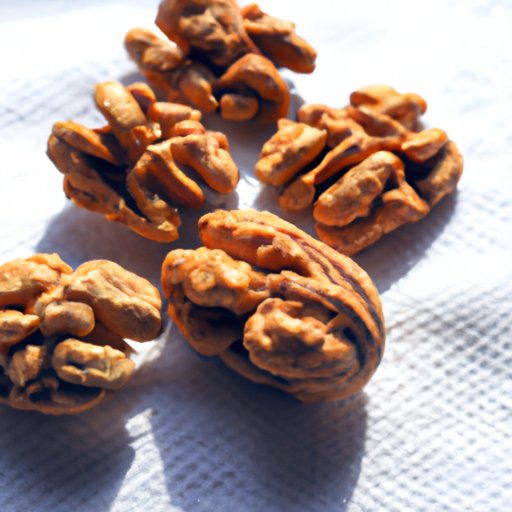Introduction
Walnuts are a type of tree nut that is often eaten as a snack or used as an ingredient in recipes. The walnut has a hard, ridged shell and a brown, wrinkled exterior. Inside the shell is the edible part, which consists of two halves connected by a thin membrane. The walnut is rich in essential fatty acids, antioxidants, minerals, and vitamins.
Benefits of Eating Walnuts
Eating walnuts can provide many health benefits. They are a source of healthy fats, protein, fiber, and other essential nutrients. Walnuts also contain antioxidants, which can help protect the body from damage caused by free radicals. Additionally, walnuts are a good source of plant-based omega-3 fatty acids, which can help reduce inflammation and improve heart health.

Using Walnuts to Add Nutritional Value to Your Diet
How to Select Walnuts
When selecting walnuts, look for ones that are plump and have a uniform shape. Avoid walnuts that are cracked, broken or have dark spots. Also, check the expiration date on the package, as walnuts can spoil quickly if not stored properly.
How to Store Walnuts
Walnuts should be stored in an airtight container, such as a Mason jar, in a cool, dry place away from direct sunlight. For longer storage, walnuts can be frozen for up to six months. To freeze, spread the walnuts out in a single layer on a baking sheet and place in the freezer. Once frozen, transfer the walnuts to a resealable bag or airtight container.
How to Prepare Walnuts
Before using walnuts in recipes, they should be shelled. To shell walnuts, place them on a flat surface and use a nutcracker to crack the shells. Once shelled, walnuts can be chopped, sliced, or crushed for use in recipes. Walnuts can also be toasted to enhance their flavor.

Health Benefits of Eating Walnuts
Nutritional Content
Walnuts are a nutrient-dense food and are packed with essential vitamins and minerals. They are high in monounsaturated fats, which can help lower cholesterol levels. Walnuts also contain omega-3 fatty acids, which are important for brain and heart health. Additionally, walnuts are a good source of dietary fiber, which can help keep you feeling full for longer and aid in digestion.
Potential Health Benefits
Eating walnuts may provide several health benefits. Studies have shown that walnuts may help reduce cholesterol levels, reduce inflammation, and lower the risk of heart disease and stroke. Additionally, walnuts may help improve cognitive function and reduce the risk of certain types of cancer.
Recipes Featuring Walnuts
Salads
Walnuts can be a great addition to salads. They add crunch and texture, as well as a nutty flavor. Try adding walnuts to a spinach salad with roasted red peppers, feta cheese, and a balsamic vinaigrette. Or toss some chopped walnuts into a kale and quinoa salad with dried cranberries and apples.
Entrees
Walnuts can be used to add flavor and texture to entrees. Try adding chopped walnuts to a stir-fry, or topping salmon with a walnut pesto. You can also use walnuts to make a vegan “meat” loaf or burgers.
Snacks
Walnuts make a great snack on their own, but can also be used to make more creative snacks. Try making a trail mix with walnuts, dried fruit, and dark chocolate chips. Or make a savory snack by roasting walnuts with garlic, chili powder, and cumin.
Desserts
Walnuts can also be used to make delicious desserts. Try adding chopped walnuts to a banana bread or muffin recipe. Or make a decadent treat by combining walnuts, dates, and cocoa powder to make raw energy balls. You can also top ice cream sundaes with chopped walnuts for a crunchy finish.
Ideas for Incorporating Walnuts into Your Meals
Breakfast
Start your day off right by adding walnuts to breakfast. Top oatmeal or yogurt with chopped walnuts for added crunch and flavor. Or make a breakfast burrito with scrambled eggs, black beans, and feta cheese, topped with a sprinkle of chopped walnuts.
Lunch
Walnuts can be a great addition to lunch. Make a hearty sandwich with smoked salmon, cream cheese, and chopped walnuts. Or toss walnuts into a quinoa and vegetable salad. You can also top a veggie burger with walnuts for extra flavor and texture.
Dinner
For dinner, try adding walnuts to your favorite recipes. Top roasted vegetables with chopped walnuts for added crunch. Or make a walnut-crusted pork chop. You can also add walnuts to pasta dishes or grain bowls for extra flavor and texture.
Conclusion
Walnuts are a nutritious and versatile food that can be easily incorporated into any diet. They are a good source of essential fatty acids, proteins, fiber, and other nutrients. Eating walnuts may also provide health benefits, such as reducing cholesterol levels, reducing inflammation, and improving cognitive function. Walnuts can be used in a variety of recipes, from salads and entrees to snacks and desserts. With the right selection and storage techniques, you can enjoy the nutritional benefits of walnuts for many months to come.
(Note: Is this article not meeting your expectations? Do you have knowledge or insights to share? Unlock new opportunities and expand your reach by joining our authors team. Click Registration to join us and share your expertise with our readers.)
